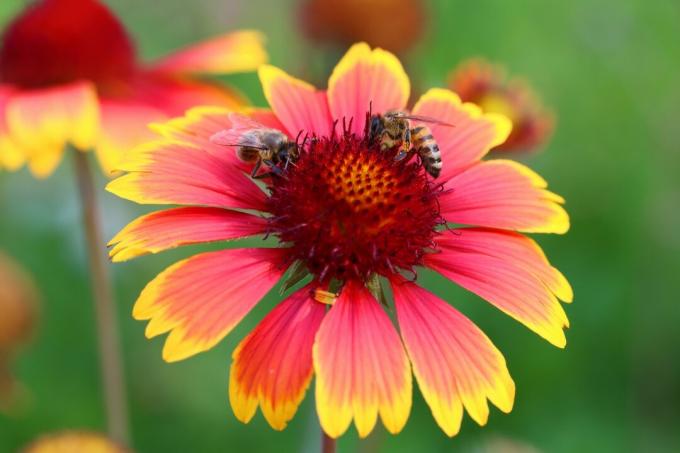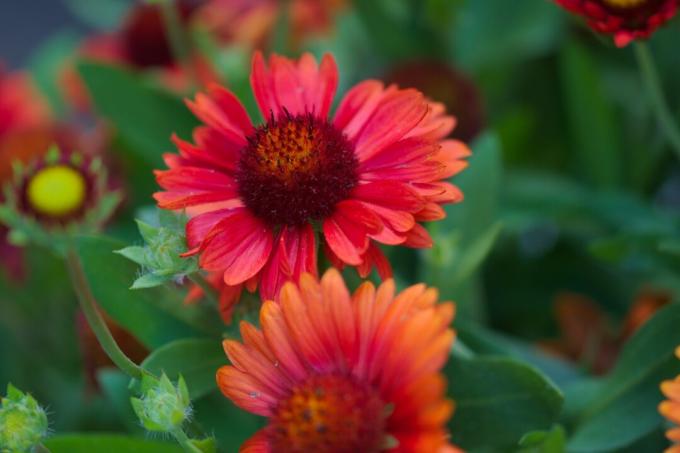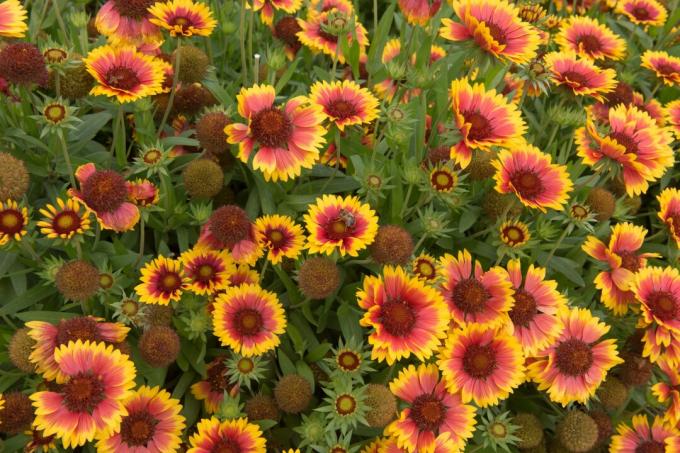The cockade flower is an eye-catcher in the bed or tub with its attractive bloom and the different shades of color. We give tips on choosing a variety, planting and caring for the perennial.

The cockade flower (Gaillardia) shows like few other perennials a mostly two-colored bloom. We provide an overview of the most beautiful varieties and tips on cultivating and caring for the perennial cockade flower.
contents
- Cockade flower: flowering, characteristics and origin
- The most beautiful varieties of cockade flowers
- Planting, location and Co.
-
Care of the Gaillardia
- Cut, water and fertilize the cockade flower
- Parrot flower does not bloom: what to do?
- Is the cockade flower hardy?
- Propagate the cockade flower
- Is the cockade flower poisonous?
Cockade flower: flowering, characteristics and origin
The cockade flower, also called parrot flower or painter's flower, originally comes from Central and North America. It belongs to the Asteraceae family and is similar to
Sunflower (Helianthus) and Mock sun hat (Echinacea) counted to the prairie shrubs. The hemispherical, bushy or upright growing, but rather short-lived perennials reach a height of between 20 and 70 centimeters, depending on the variety and species. The leaves of the cockade flower are pinnate at the base, lanceolate and hairy on the stem.The flower of the parrot flower can grow to be more than ten centimeters and is traditionally two-tone in red with yellow-orange edges. The petals can also be rolled up in certain varieties. The long flowering time of the cockade extends from June to September. It is valuable for bees and other insects because it has a long flowering time and also provides pollen in the otherwise often nutrient-poor midsummer. After pollination, the perennial forms funnel-shaped seeds with a white appendage that allows wind to spread, the pappus. They spread around the mother plant and over long distances.
tip: Cockade flowers are largely avoided by snails and other pests.

The most beautiful varieties of cockade flowers
Among the diverse varieties of cockade flowers are mostly hybrids, the so-called large-flowered cockade flowers (Gaillardia x grandiflora). Varieties of the prairie cockade flower (Gaillardia aristata), which usually remain smaller than hybrid varieties.
- ‘Arizona Sun‘: Cockade flower of the species Gaillardia aristata with orange-red flowers and yellow tips. The plants reach a height of only 30 cm.
- 'Burgundy': German breed from 1931 with large flowers and completely wine-red petals and a height of 60 - 70 cm.
- 'Bremen': Upright, slender variety with margerite-like, dark red flowers with yellow tips and a height of up to 60 cm.
- ‘Torchlight‘: This cockade flower has very large flowers and a clump-like, upright growth up to 70 cm. The petals are colored deep red, while the tips shine sun-yellow.
- 'Leprechaun': Dwarf compact growth up to 30 cm and two-colored petals; the variety is ideal for planting pots and window boxes.
- ‘Mesa Peach‘: Cockade flower with red-orange-yellow flowers and a height of up to 40 cm.
- ‘Tizzy‘: Deep blood-red, pale orange or yellow flowering mixture of varieties with particularly attractive, rolled-up petals.

Planting, location and Co.
Cockade flowers can be grown from seeds or planted directly in the ground as a perennial. The cockade flowers are sown between April and May in the cold frame or on the windowsill. The light germs are not covered with soil, but only spread on a potting soil, lightly pressed and carefully watered. At temperatures of around 15 ° C, the seeds will germinate after two to three weeks. By the time they are planted out at the end of May, the cockade flowers should be pricked out, converted into nutrient-rich potting soil and later slowly hardened outdoors. Parrot flowers raised from seeds bloom for the first time around 14 to 20 weeks after sowing.
If you have bought cockade flowers from a nursery as a large perennial, you should end up in late autumn Can be planted October or early spring while the perennial is in hibernation is located. Instead of leaves, the cockade flower initially only forms roots and can supply itself with water and nutrients more quickly. Due to the approaching summer, plantings should be watered more often in spring until a sufficiently large root system has formed. The ideal location for cockade flowers is sunny. But which soil is suitable for the cockade flower? Nutrient-rich and humus-rich soils with good water storage capacity are ideal. A high-quality, nutrient-rich potting soil like ours Plantura organic potting soil, meets all of these soil quality criteria. In addition to being used for potted plants, it is therefore also suitable for improving garden soils.
First of all, the soil is loosened over a large area before you dig a large planting hole. The planting distance of cockade flowers is 30 to 50 centimeters, depending on the variety. Put the perennials in it and fill the hole with substrate. Cockade flowers can also be kept in the bucket, but the planter should hold at least 10 to 15 liters of soil. Fill the bottom of the pot with a drainage layer made of gravel, sand or expanded clay to avoid waterlogging.
tip: In terms of color, cockade flowers go particularly well with other sun-loving perennials such as delphinium (Delphinium), Rudbeckia (Rudbeckia) or Feinstrahlastern (Erigeron) combine.
Care of the Gaillardia
In addition to watering and a few fertilizers, caring for the cockade flower mainly consists of pruning it after flowering, which is essential for good winter hardiness and longevity.
Cut, water and fertilize the cockade flower
In general, when cutting the cockade flower, care is taken to ensure that withered and faded elements are removed regularly. On the one hand, this prevents diseases and, on the other hand, promotes the formation of new flowers during the summer. Without regular pruning, cockade flowers are unfortunately quite short-lived. A hand-high pruning of the entire plant after flowering in September is necessary annually and promotes winter hardiness and the formation of young buds for the next year. If you cut back too late, the cockade flower may not survive the winter. The perennials are quite drought-tolerant as prairie plants, but regular watering is necessary in hot summers and with cockade flowers in pots.

Cockade flowers in the tub should be given a new, larger pot with fresh potting soil and some fertilizer every two to four years, depending on their growth. Fertilizing cockade flowers in the bed is also useful in spring to support leaf shoots and flower formation. A mainly organic slow release fertilizer like ours Plantura organic flower fertilizer, releases the nutrients it contains slowly and gently over a period of around three months. The granular fertilizer is easily incorporated into the soil or substrate and the nutrients are made available to plants through the activity of soil organisms.
Parrot flower does not bloom: what to do?
There are various reasons why the attractive parrot flowers cannot or would not bloom. Many problems can arise from location, irrigation and fertilization and can be solved quickly:
- Inappropriate location: Move or relocate the plant
- Water supply: Avoid drought and waterlogging
- Nutritional deficiency: Repotting and fertilizing
- Perennial grow old: Rejuvenation of the stock by pruning back after flowering and division, possibly re-sowing necessary
Cockade flowers are comparatively short-lived perennials that age quickly and hardly grow or bloom after just four to five years. Often times this is because the plants were not pruned back radically enough, or never divided, to promote their longevity.

Is the cockade flower hardy?
The cockade flower is hardy to below - 20 ° C if it has been cut back in good time in September. Winter protection may be necessary in very rough locations. An insulating mulch layer made of leaves and coniferous branches or sheep's wool protects the cockade flower from harsh freezing temperatures. Parrot flowers in pots should either overwinter frost-free in their winter quarters or be wrapped well with jute and fleece so that the root system is not damaged by frost. Winter protection should definitely be attached to freshly planted perennials.
Propagate the cockade flower
In principle, cockade flowers can be propagated from their seeds, they also like to sow themselves in the bed. For seed production, the plant must not be cut back after flowering. In October, the seed heads can be cut off and dried in the house until the seeds separate by themselves. After further drying, they can be stored in a cool, dry and dark place. The parrot flowers are more easily propagated by dividing the perennial. In late autumn, a piece of the existing stick is simply cut off with a spade and moved to a suitable location. Dividing is also a measure for rejuvenation, because it promotes the flowering pleasure and longevity of the perennial. A division should therefore take place every two to four years.

Is the cockade flower poisonous?
Basically, the cockade flower is not poisonous, but it contains gaillardin, which can cause contact allergies on the skin in sensitive people. Use gloves as a precaution when pruning the plant.
A distant relative of the cockade flower is the Knapweed (Centaurea), which with its delicate flowers in a wide variety of colors fits into every herbaceous bed.



